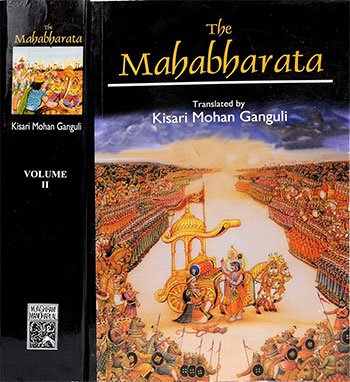Section XLVI - Sanat-sujata on Brahman: Eternal Divinity Revealed by Yogins
Book index: Mahabharata (English)
This page contains a summary of the Mahabharata Section XLVI including examples of moral lessons in daily life. The Maha-Bharata is one of the largest epics ever written containing roughly 100,000 Sanskrit verses. It deals with the legendary history of ancient India and contains a large number of interwoven tales.
Short summary of the chapter:
Sanat-sujata describes the primary Seed of the universe, Mahayasas, as a pure and self-luminous entity that is the source of all creation. Yogins can behold this Eternal One endued with Divinity through their mental eye. This Seed upholds the universe, including the Earth, Heaven, directions, and rivers, and is the source of light and heat.
The body, composed of the five elements, is upheld in consciousness by both the creature-Soul and Isvara, with Brahman as the underlying source of everything. The stream of illusion, guarded by gods and offering twelve fruits, leads beings to swim along it in the cycle of life and death. The creature-Soul, influenced by Avidya, takes births based on propensities and is guided by accidents springing from Brahman.
The Supreme Soul is described as the controller of the five elements, Agni and Soma, living organisms, and more, originating from the eternal Seed. The vital air Apana is swallowed up successively by Prana, the Will, the Intellect, and the Supreme Soul. The Supreme Soul, manifested as Pure Knowledge in creature-Souls, can be beheld by those with purified hearts and minds.
Individuals who have mastered their minds and purified their hearts can attain the Supreme Soul and reach emancipation. The person who knows Brahman is unaffected by good or bad actions, seeing themselves as identical with Amrita or the state of Kaivalya. By beholding their own Self in everything, they find joy and freedom from grief, realizing that the Universal Father dwells in the heart of every being.
Full English translation:
This page is merely a summary which is automatically generated. If you are looking for authentic sources such as the Sanskrit text or the Full English translation of Mahabharata Section XLVI - Sanat-sujata on Brahman: Eternal Divinity Revealed by Yogins, have a look at the following articles:
Section XLVI, online text
English translation by Kisari Mohan Ganguli.
Read this and other chapters online.
Mahabharata (English Summary)
by Kisari Mohan Ganguli | ISBN-10: 8121505933
Buy the latest edition:
FAQ of Mahabharata, Section XLVI:
What is the primary Seed of the universe according to Sanat-sujata?
The primary Seed, called Mahayasas, is pure Knowledge and leads the senses.
How is the Eternal One endued with Divinity described by Yogins?
Yogins describe the Eternal One as self-luminous, all-encompassing, and the Supreme Soul.
What is the significance of the Seed in relation to creation and existence?
The Seed upholds gods, Earth, Heaven, Directions, and the whole Universe.
How can one attain emancipation and liberation according to the text?
One must know Brahman, see the Self in everything, and restrain the mind.
Daily life: Sanat-sujata on Brahman: Eternal Divinity Revealed by Yogins:
The profound message drawn from the story focuses on the significance of realizing the true nature of the Eternal Divine, which is beyond physical form and perceivable senses, and is accessible through the pursuit of spiritual wisdom and purification of the heart. To incorporate this wisdom into daily life, one must strive to cultivate a deep sense of self-awareness by recognizing the divinity within oneself and in all creations. This involves transcending beyond the tangible aspects of existence and fostering a connection with the spiritual essence that pervades the universe.
Engaging in practices that quiet the mind and nurture the soul, such as meditation, yoga, and mindful contemplation, can help one attune to this universal consciousness. By doing so, an individual begins to perceive life from a holistic perspective, where the dichotomies of joy and sorrow, birth and death, and other worldly dualities are transcended, revealing a state of unity and peace.
In daily interactions and decisions, this understanding encourages one to act with compassion, empathy, and a sense of universal responsibility, recognizing the interconnectedness of all beings. It challenges individuals to live in the present, free from the bondage of past actions or future anxieties, and to embrace the flow of life with acceptance and grace. By embodying these principles, one not only contributes to personal growth and liberation but also fosters a world that is more harmonious and enlightened.
